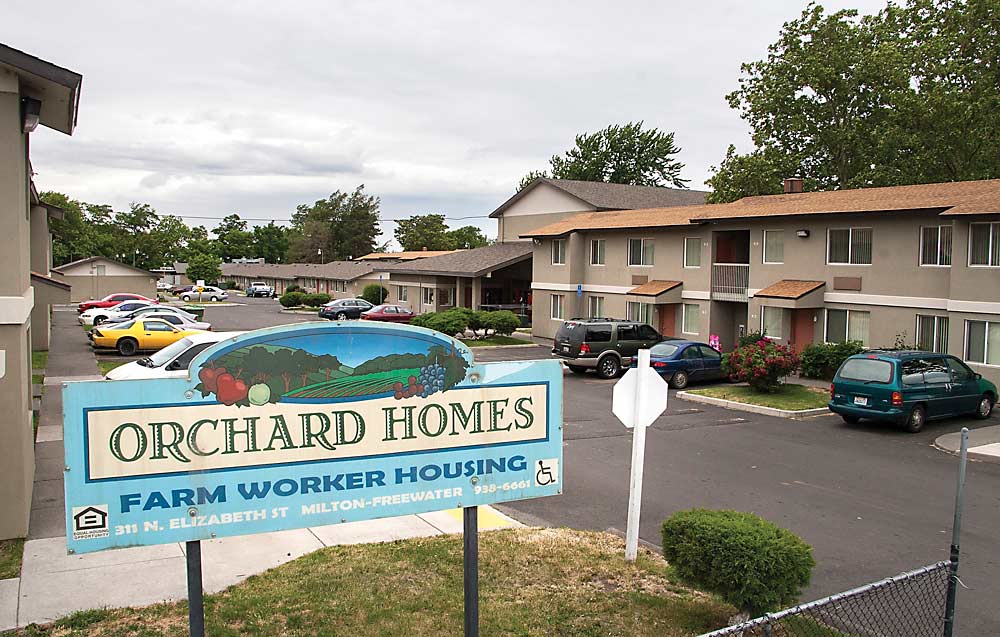
The growers who own Orchard Homes, a farmworker residence facility in Milton-Freewater, Oregon, shown in 2016, may now house H-2A workers due to changes in U.S. Department of Agriculture loan regulations.(Ross Courtney/Good Fruit Grower)
A change in federal rules has opened up a U.S. Department of Agriculture loan program to farmers who want to house H-2A workers.
Last year’s provision extends federal Section 514 loans to farmers purchasing, building, renovating or expanding housing for foreign workers in the United States on a temporary H-2A visa. Previously, the funding was limited only to facilities housing domestic workers.
The changes came about after U.S. Rep. Dan Newhouse, a Washington Republican, successfully proposed an amendment to the 2018 Consolidated Appropriations Act.
Agriculture groups, including those that represent the tree fruit industry, have been seeking incremental improvements to the H-2A program through appropriation for several years, said Diane Kurrle, senior vice president for USApple in Falls Church, Virginia.
“This important change to the 514 housing was a top priority and a change we worked to advance over several years,” she said.
Foreign guest workers make up a larger share of the agricultural workforce every year and growers must, by law, provide housing for them. The U.S. Department of Labor certified 242,762 H-2A positions between October 2017 and September 2018, a 47 percent jump from the same period two years earlier and a fourfold increase from 2005–2006.
The change provides a much-needed market for Orchard Homes, a Milton-Freewater, Oregon, apartment complex built and owned by area growers for labor housing.
“I don’t think there’s any question it will be a great option to have,” said Tom Waliser, an apple and grape grower and member of the Orchard Homes board of directors.
Orchard Homes, built by growers in the 1950s, was featured in an August 2016 story in Good Fruit Grower. The restriction to domestic workers and changing demographics of orchard labor in the area left the facility low on tenants and struggling to repay its $1.4 million in loans to the federal government.
Board members had considered selling the place to someone else to run as traditional, year-round apartments.
Orchard Homes has not put up any H-2A workers since last year’s rule changes, Waliser said.
For one thing, it takes a while for growers to adjust. Contracting foreign workers takes months and months of planning. The formal application process alone is at least 60 days long.
Also, Orchard Homes is not in such dire straits now, Waliser said. The local housing market has sent more tenants its way and the facility now is roughly 80 percent occupied. Meanwhile, the group has secured about $8 million in grants and loans for upgrades, which the board members think are worthwhile now that the housing market has shifted.
Still, Orchard Homes will eventually get H-2A workers simply because the labor market will push more growers to hire them, Waliser said.
“We have a huge labor issue that’s not going to go away and it’s just going to get worse,” Waliser said.
The changes would have come in handy a few years earlier for Damon Glei, a third-generation grower in Hillsdale, Michigan.
He first tried contracting H-2A workers about five years ago but was not allowed to put them up in his 21-bed housing units, built with a USDA Section 514 loan. Per the advice of USApple, in 2016, he borrowed money from his retired parents to pay off the remaining $50,000 loan and remove his housing from the Section 514 program.
The federal government at first told him no; the facility was built with Section 514 funding and could not be used for H-2A workers, regardless of his loan status, he said.
He kept trying and eventually convinced the USDA to accept the payment and remove his facility from the program in March or April of 2017. The process took six months, and that entire time he was busy preparing a contract for H-2A laborers with a May deadline.
In the end, he made it, and in late March this year he was submitting his contract for a third round of H-2A workers.
“The program has been a savior to our business in reference to getting labor to do needed jobs,” he said. •
—by Ross Courtney
Related: Red tape keeps some workers out






Leave A Comment